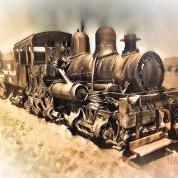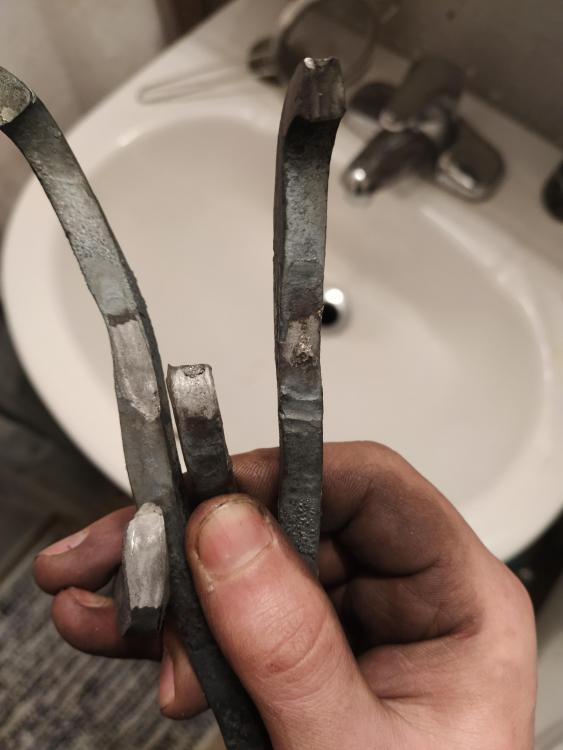
JYForge
Members-
Posts
4 -
Joined
-
Last visited
Recent Profile Visitors
3,392 profile views
-
What is the wall thickness? It is probably best used by cutting off a length and slitting an edge so you can unwrap it and have a flat sheet. Then you can make bowls, spatulas, ladles, spoons, etc from the sheet. An abrasive cutoff wheel works great for cutting stainless. Also, there is a process to restore stainless steel after hot work, you will want to look that up. As mentioned, rivets are probably the best way to attach a handle. I would keep the tube for other uses as well. SS tube is good for canister welds if you get into that down the line, you can also fabricate a stand or stool if you have an electric welder.
-
I did try once with brand new from the steel dealer cold rolled AISI 1045, forged it into 3/8" square, clean the scale off to shiny steel. The weld could be broken just as easily as the other pieces I make my scarves about as long as the parent material, maybe a bit longer so about a 3/8-1/2" long. The remnants in the photos above look about double that because they get elongated when refining the material. I will try a bit shorter. I will also try welding the scarf first next time, that sounds like a good idea, because i do have trouble blending that in sometimes. I think your comment about being too near the forge burner is probably the root of my problem. I was reading about why you cannot weld steel with Oxypropane torches, and it looks like the main issue is that it is too oxidizing of an environment even if regions are reducing. I think my forge may just not be a good forge design for welding, because the only region that is hot enough to weld is about a 2" length of the chamber right around the outlet of the burner I am a bit surprised that I can can get it to stick together, or weld a pointed rod in the forge with it being too oxidizing (I thought the flux was giving me some more margin here), but i guess just because it sticks initially doesn't mean it is going to be a good weld? I also tried adding some powder metal (1095 powder) into the flux to see if it helps (maybe a 50-50 mix), and it seems worse, like the weld was very crust when i broke it apart and barely holding together which might indicate that the oxidizing issue really is the main one Sorry, my photos could have been clearer, the photos are after i split apart the two pieces and are showing the weld plane. The do not show the side view. The cross section started as two 3/8" pieces (3/8" x 3/4"), and i usually forge until it is 3/8" in height. so I reduce the height of the weld by about half. Perhaps my technique for refining the weld is poor? After the pieces are tacked together with the light blows and stuck, i usually progress to a medium blow (think straightening a slight bend in a 3/8" bar) with a 1.5 lb hammer and then full hard blows with the 1.5 lb hammer. Maybe I am working the sides too soon? Maybe i need to do harder blows sooner? Thank you all for the comments, I will see if I can use a friends propane forge that I know gets much hotter than mine (he can melt steel using it) and see if I can get better welds. One more comment: I have been reading up on this issue and I saw some posts about axe making with wrapped eye construction where people were warning about eyes splitting easily if you drift too aggressively indicating to me that the parent material is significantly stronger than the weld. This was surprising to me, because looking at my post vice, there are a lot of forge welds on it, like the two plates that create the lower pivot connecting the two legs together. These welds have no scarfing and minimal apparent drawing out after the weld and the joint has predominantly shear stresses on the welding plane, but it has held up to a lot of abuse . I wonder how many people actually test their mild steel forge welds made in a propane forge in this way? Perhaps this weakness is more common, but a lot of people are unaware that their welds are weak because they look fine are not tested? Thanks -Josh
-
Hello, I did a search on old posts, but I did not find a post that solved this, forgive me if I missed the one(s) The quick and dirty is that my welds are very weak, The long details are below: I have been struggling with forge welds being very weak. I am welding in a gas forge (single Venturi burner, side entry 3x4 cross section about 12” long), I think the flame is very close to neutral based on the color of the flame being right on the edge of transitioning from green to blue when I adjust the choke. (maybe there is a way I can test that better?) The weld I am working on is a faggot weld of 3/8" square bar to itself. Either bent back in a loop and scarfed or two together (ends aligned and not scarfed). Hot rolled Mild steel (whatever comes from the steel yard) I have tried this about a dozen times and usually get the same result. I grind off the mill scale so that the steel is bare and shiny, then I heat to red and flux with borax. Then I bring up the heat until all the borax is bubbling vigorously. I would describe the color as a bright yellow. If I take a pointed piece of the mild steel and press it to the bars at this temp in the forge, it welds instantly and I can lift the piece with the pointed piece and need to twist to get it off. I pull it out and weld it on the anvil with 3 light, quick blows and the pieces are stuck together. The anvil is very close to the forge (within 2 feet) and I make sure to waste no time. I always get them to stick. I take a second heat and go over the weld again from the other side. I then take another welding heat and focus on blending the scarf with the pein. Next I go over one edge and blend it and then the other. By now, the two pieces look completely blended, when they heat I can see no seam and the scale forms uniformly. I sometimes forge it down again at welding heat. Then I let it air cool to room temp and test the weld by bending it in a vice by pulling on piece away from the other. Every time the weld pops open with not much effort, maybe 10 or 15 lbs of force on a 6 in piece . The surfaces look shiny, sometimes a small section tears out, but I can never get that level of adhesion over the entire surface. (See image of two attempts, both were loops that I bent back on themselves and then split after welding and tested I have tried this a lot of time with varied strength of the blows, normalization cycles, using new 1045 (instead of mild) that I forge to 3/8”, forging the section down more, fluxing cold, not fluxing. I even took out my oxypropane torch and tried it with borax and got the weld to stick, but then had the same failure in testing. Could I have a contaminate in my flux? Is my forge more oxidizing than I think (I tried going richer, but then I struggle getting to temp)? I really feel stuck and would really appreciate some help Thank you, -Josh
-
Experience with Blacksmiths Paradise?
JYForge replied to bajajoaquin's topic in Anvils, Swage Blocks, and Mandrels
I bought some anvils from Emerald for me and a friend who blacksmith and ended up with a terrible experience. He was very friendly and responsive to emails. The anvils shipped, but it costs a lot more than he mentions because you have to pay customs and a custom broker fee and other transportation fees, I think it ended up costing about $1250 to get the pallet to a local depot where I could pick it up from. It would have been more to get it to my house. He did a great job packing the anvil. The anvils looked all as described and we were initially pretty happy with the purchase, however, One of the anvils arrived and I was cleaning it up and discovered a very large crack that extended the full length of the side of the flat horn. I then rung the anvil with a hammer and realized it sounded completely flat. It was a dead giveaway the crack was significant. It was a large 300 kg anvil and I looked at his photos and you just could barely make it out in the photos if you knew exactly what you were looking for, so it was not from shipment. I contacted him and informed him politely of the situation and if he felt like I was SOL, or if he would be willing to put some money towards a repair because he had described the anvil in outstanding condition and I had been a good customer who purchased a few anvils. I thought it was an honest mistake, but based on his lack of response and that a rebound test or a hammer would quickly let you know there is an issue with the anvil, i am not sure about him. He never contacted me back, I attempted 3 emails and called, always no answer or call back. It left a bad taste in my mouth that he wouldn't even say "sorry, they are all sold as is" I payed a friend who is a professional welder to grind out the crack and weld it back up, took him 12 hours between the arc gouging and the welding, the crack went about 3 inches deep (half way across the face) and the whole depth of the flat horn (about 10") Still bothers me every now and then, and this was over a year ago

